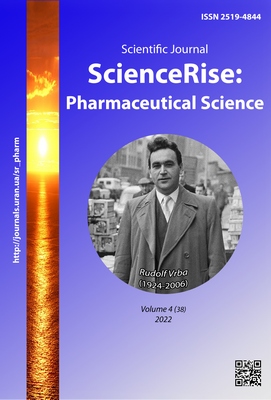Розробка методик дослідження дицикломіну гідрохлориду в комбінації з парацетамолом у формі таблеток як об'єкту судово-фармацевтичної експертизи
DOI:
https://doi.org/10.15587/2519-4852.2022.261007Ключові слова:
немедичне використання, психоактивні речовини, судово-фармацевтична експертиза, виявлення лікарських речовинАнотація
Мета. Підбір та розробка методів для завдань судово-фармацевтичної експертизи матеріалів справ з підозрою на фальсифікацію чи немедичного використання дицикломіну в комбінації з парацетамолом в формі таблеток.
Матеріали та методи. У дослідженні представлено розроблені методи виявлення та ідентифікації дицикломіну методами ТШХ, ІЧ-спектроскопії та ГХ-МС, які проводили з використанням реактивів, що відповідають вимогам EP, USP та USPU, посуду класу А та кваліфікованих приладів.
Ідентифікацію методом ІЧ-спектроскопії проводили в діапазоні від 500 до 4000 см-1 на приладі “Nicolet 380 FT-IR Spectrometer by Thermo Fisher Scientific”.
ТШХ проводили на пластинах Сорбфіл ПТСХ-П-В-УФ та Сорбфіл ПТСХ-АФ-А-УФ (ЗАТ «Сорбполімер», Росія). В якості рухомих фаз використовували системи: діоксан-хлороформ-ацетон-25 % розчин аміаку (47,5:45:5:2,5); толуол-ацетон-етанол-25 % розчин аміаку (45:45:7,5:2,5); етилацетат-метанол-25 % розчин аміаку (17:2:1)). Утворені хроматографічні зони виявляли опроміненням УФ-світлом і подальшою обробкою реактивами (30 % розчин ферум(ІІІ) хлориду; реактив Драгендорфа, модифікований Мюньє; реактив Маркіза; реактив Фреде; реактив Манделіна; реактив ФПН).
Аналіз методом газової хроматографії з мас-детектуванням проводили за допомогою газового хроматографа з мас-спектрометричним детектором GCMS-QP2020. Дані аналізували за допомогою програми: GCMSsolution, LabSolutionsInsight (Shimadzu Corporation, Токіо, Японія).
Результати. Вперше вивчено умови екстракції дицикломіну гідрохлориду з водних розчинів та визначено оптимальні умови їх ізолювання як об'єкта судової експертизи. Розроблено методики виявлення дицикломіну гідрохлориду та парацетамолу в препараті «Триган-Д» методами тонкошарової хроматографії, газо-рідинної хроматографії та хроматомас- спектрометрії, визначено межі виявлення досліджуваних речовин.
Висновок. Розроблені методи визначення дицикломіну гідрохлориду в формі таблеток з парацетамолом відповідають вимогам чинного законодавства України та Міністерства юстиції України. Отримані дані доводять високу чутливість і відтворюваність методів і доводять можливість їх впровадження в практику судової експертизи
Посилання
- Bevz, O., Sych, I., Shaposhnyk, A., Sych, I., Kryvanych, O., Taran, S., Perekhoda, L. (2021). Development of determination methods of quetiapine fumarate for forensic-pharmaceutical purposes. ScienceRise: Pharmaceutical Science, 2 (30), 4–12. doi: http://doi.org/10.15587/2519-4852.2021.228132
- Sych, I. V., Bevz, O. V., Sych, I. A., Shaposhnyk, A. M., Zarubina, M. V., Kryvanych, O. V. et. al. (2021). Development of the method for determining Methandienone in Toxicology and doping-analysis. Research Journal of Pharmacy and Technology, 14 (10), 5169–5174. doi: http://doi.org/10.52711/0974-360x.2021.00899
- Singh, V. V., Gupta, S., Sarkar, S., Chatterjee, B. (2020). Problematic dicyclomine use: A case report and narrative review. Asian Journal of Psychiatry, 48, 101891. doi: http://doi.org/10.1016/j.ajp.2019.101891
- Das, S., Mondal, S., Datta, A., Bandyopadhyay, S. (2013). A rare case of dicyclomine abuse. Journal of Young Pharmacists, 5 (3), 106–107. doi: http://doi.org/10.1016/j.jyp.2013.08.004
- Zupanets, I. V., Ruban, O. A., Ievtushenko, O. M., Kolisnyk, Т. E. (2020). Assortment research of analgesic drugs for chronic pain treatment on pharmaceutical market of Ukraine. Farmatsevtychnyi Zhurnal, 3, 16–28. doi: http://doi.org/10.32352/0367-3057.3.20.02
- Chiappini, S., Mosca, A., Miuli, A., Semeraro, F. M., Mancusi, G., Santovito, M. C. et. al. (2022). Misuse of Anticholinergic Medications: A Systematic Review. Biomedicines, 10 (2), 355. doi: http://doi.org/10.3390/biomedicines10020355
- Glogić, E., Jasak, Z. (2021). Benford’s Law in Forensic Analysis of Registered Turnover. Journal of Forensic Accounting Profession, 1 (1), 50–60. doi: http://doi.org/10.2478/jfap-2021-0004
- Sinha, S., Dhiman, S., Sidana, A. (2020). A rare case of dicyclomine and mefenamic acid abuse fulfilling criteria of dependence syndrome. Indian Journal of Psychiatry, 62 (6), 740–741. doi: http://doi.org/10.4103/psychiatry.indianjpsychiatry_562_19
- Singh, V. V., Gupta, S., Sarkar, S., Chatterjee, B. (2020). Problematic dicyclomine use: A case report and narrative review. Asian Journal of Psychiatry, 48, 101891. doi: http://doi.org/10.1016/j.ajp.2019.101891
- Reiestr metodyk provedennia sudovykh ekspertyz. Ministerstvo yustytsii Ukrainy. Available at: https://expertize-journal.org.ua/reestr-metodik-sud-expertiz
- Rapid testing methods of drugs of abuse (1994). United nations international drug control programme. New York: United Nations, 105.
- Malathi, R., Amol, D., Jyotsna, P. (2015). Simple UV spectrophotometric method for estimation of dicyclomine hydrochloride in bulk and tablet formulation. International Journal of Pharmaceutical Research and Allied Sciences, 4 (3), 109–113.
- Susmithaa, K., Chary, M. T., Venkateshwarlu, G. (2011). Assay of dicyclomine hydrochloride in pharmaceutical formulations by extractive spectrophotometry. International journal of chemical science, 9 (3), 1353–1363.
- Rawool, C. R., Rajpurohit, A. S., Punde, N. S., Srivastava, A. K. (2018). Adsorptive stripping voltammetric determination of dicyclomine hydrochloride at a glassy carbon electrode modified with silver decorated Fe3O4 nanocubes in pharmaceutical and biological samples. Analytical Methods, 10 (12), 1441–1451. doi: http://doi.org/10.1039/c8ay00009c
- Wadher, S. J., Kalyankar, T. M., Kshirsagar, J. R., Anitha, K. (2017). Simultaneous Determination of Famotidine and Dicyclomine HCl in combined Tablet Dosage form by UV-Spectrophotometer. Research Journal of Pharmacy and Technology, 10 (2), 408–413. doi: http://doi.org/10.5958/0974-360x.2017.00082.8
- Ciura, K., Rutecka, A., Szewczyk, A., Kawczak, P., Bączek, T., Nowakowska, J. (2019). Study of the chromatographic behavior of selected antipsychotic drugs on RP-TLC based on quantitative structure–retention relationships. Journal of the Iranian Chemical Society, 16 (5), 1019–1027. doi: http://doi.org/10.1007/s13738-018-01576-0
- Chaitany, D. A., Tiwari, S. K., Brahmbhatt, K. D., Patel, P. M., Shah, S. B. (2013). Development and validation of RP-HPLC method for estimation of omeprazole and dicyclomine hydrochloride in pharmaceutical dosage form. Pharma science monitor. An international journal of pharmaceutical sciences, 4 (3 (1)), 247–256.
- Nutan, R., Akshata, D. (2021). RP-HPLC Method Development and Validation for Estimation of Dicyclomine Hydrochloride in its Bulk and Drops Form. Research Journal of Pharmacy and Technology, 14 (2), 605–609. doi: http://doi.org/10.5958/0974-360x.2021.00108.6
- Tumylovych, E. Yu., Karpenko, Yu. N., Dvorskaia, O. N. (2010). Opredelenye komponentov preparata" Tryhan D" v moche pry khymyko-toksykolohycheskom analyze. Narkolohyia, 9 (9), 46–51.
- Moore, S. (2021). How is infrared spectroscopy used in key forensics applications? AZoOptics. Available at: https://www.azooptics.com/Article.aspx?ArticleID=1929
- Biscevic-Tokic, J., Tokic, N., Ibrahimpasic, E. (2015). Chromatography as method for analytical confirmation of paracetamol in postmortem material together with psychoactive substances. Acta Informatica Medica, 23 (5), 322–325. doi: http://doi.org/10.5455/aim.2015.23.322-325
##submission.downloads##
Опубліковано
Як цитувати
Номер
Розділ
Ліцензія
Авторське право (c) 2022 Olena Bevz, Igor Sych, Andrii Fedosov, Olha Vislous, Irina Sych, Olga Kryvanych, Nataliia Kobzar, Lina Perekhoda

Ця робота ліцензується відповідно до Creative Commons Attribution 4.0 International License.
Наше видання використовує положення про авторські права Creative Commons CC BY для журналів відкритого доступу.









